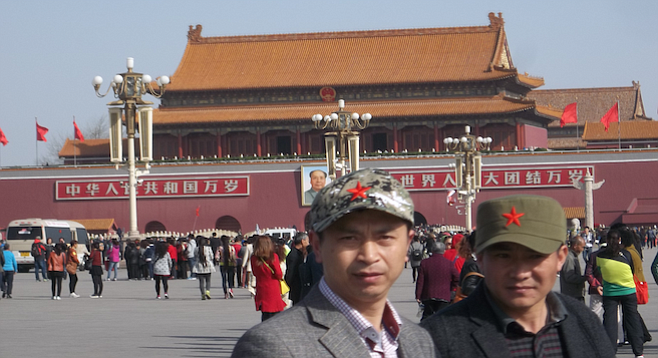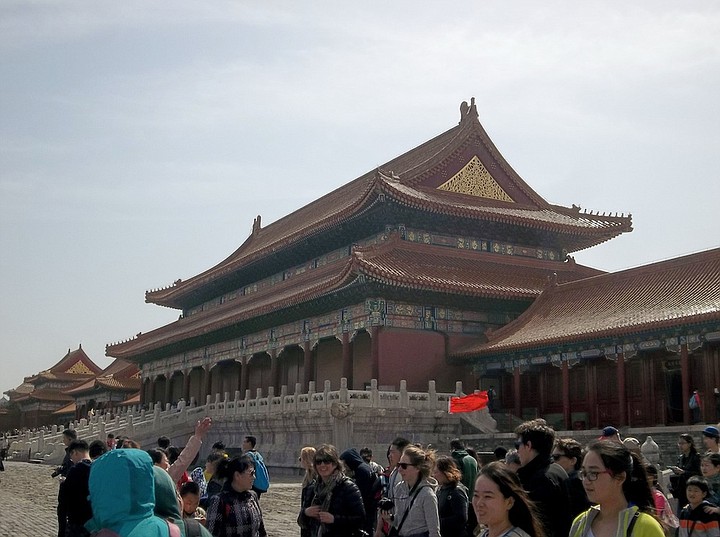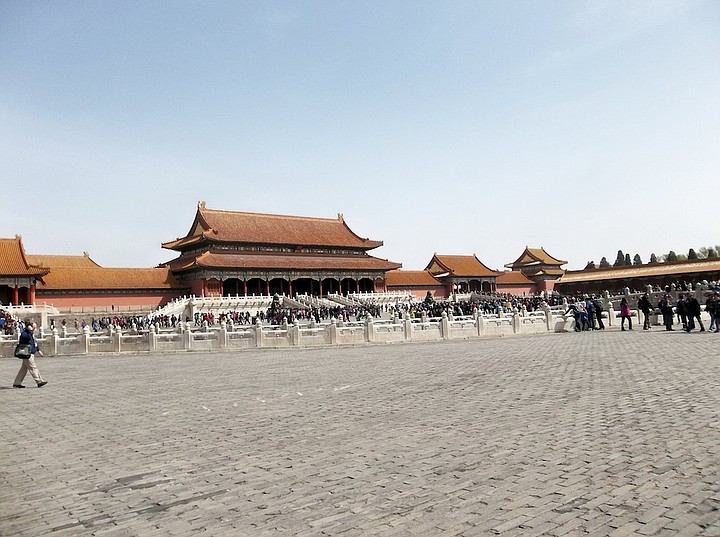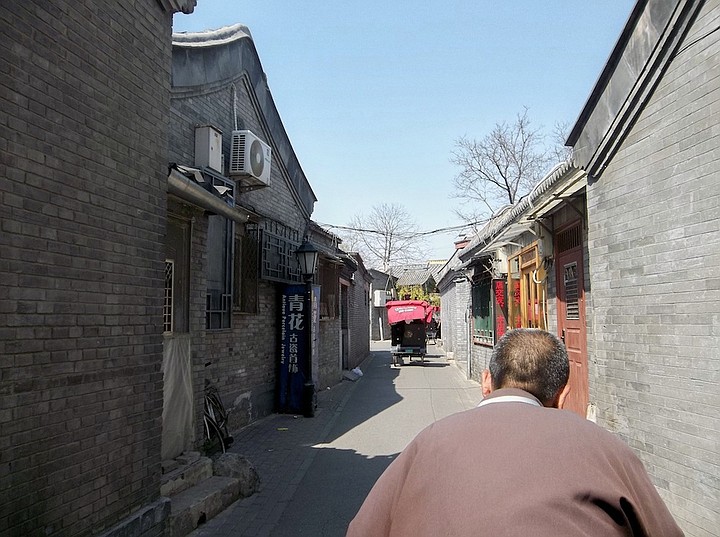 Facebook
Facebook
 X
X
 Instagram
Instagram
 TikTok
TikTok
 Youtube
Youtube

I stood in Tiananmen Square (above) on a windswept, sunny morning, and gazed at the locals and tourists milling about under the watchful visage of Chairman Mao’s portrait. Having just arrived in China the previous night, I was jetlagged and dazed at the surreal experience. For years I had imagined what it would be like to wander about in this huge space, the largest public square in the world.
My mind flashed back to news reports describing the student protests held here in 1989 and the subsequent brutal crackdown by the government. I was captivated at the time by the courage and yearnings of the protesters. But I dared not bring up this subject to my guide.
“Please don’t discuss politics with me at Tiananmen,” my personable, knowledgeable guide, Peng (American name: Nick), warned us in advance.
“If you do, I may be sent to the re-education center.”
Okay. I could only imagine in my worst nightmare what a stay there might entail, so I censored my questions and comments. My lips were sealed. Still, I wondered what happened to that guy who stood in front of the tanks a few days before the massacre.
Recuperating from a pesky case of bronchitis that left me with a persistent cough, I had been very concerned about the air quality in Beijing, especially after watching the Chinese documentary Under the Dome on YouTube about the country’s lousy air quality.
We caught a break, however; the infamous Beijing hazy “mist” I’d heard so much about was absent. The sky was blue and a cool spring breeze was blowing. The air quality didn’t seem as abysmal as I had feared. There were, nevertheless, a fair number of locals who were wearing masks (including some panda masks).
Less than a week after I returned home from China, a severe sandstorm – worst in a decade – hit Beijing, startling many of the locals and underscoring how we lucked out weather-wise and air quality–wise.
We walked through an underground passage under Chang’an Avenue (English: Eternal Peace Street) before the watchful eyes of stern-looking police to gain entrance to the Forbidden City, a vast cluster of buildings and squares that was for 500 years restricted to the emperor and his personal coterie of eunuchs and concubines. I imagined Pu Yi, the last emperor, riding his bike around the exterior squares – his personal prison, in essence – as portrayed in the Oscar-winning The Last Emperor.
“A million people, including 100,000 artists, were involved in the building of the Forbidden City,” Peng relayed to us.

We continued past the central buildings of the breathtaking complex, the Hall of Supreme Harmony and the Hall of Complete Harmony. Then past the Hall of the Preserving Harmony where the dining hall was located. Toward the rear of the complex, we explored the imperial garden and the emperor’s private quarters, the Hall of Mental Cultivation. It was hard for me to wrap my head around the power and privilege experienced by these emperors.

As we exited the Forbidden City, we walked along a path lined with beggars, many of whom were missing limbs or otherwise disfigured – a stark contrast to the lavish lifestyle that had just been described to us.
The city (and China itself) is engulfed in a fascinating tension between the old and the new. The rapid rate of construction is apparent in Beijing as you travel about the city and see the numerous high rises under construction. Our hotel, Traders, part of Beijing’s World Trade complex, was directly across the street from the tallest skyscraper in Beijing, World Trade Tower Center 3, which bears a strong resemblance to the NYC twin towers destroyed on 9/11.
We were scheduled to have lunch at a local residence in one of Beijing’s few remaining hutongs – the city’s traditional neighborhoods of back-alley homes and courtyards near the Forbidden City. An interconnected maze, the hutongs now are a refreshing reminder of old Beijing. According to Peng, just a few years ago there were about 5,000 hutongs; now there are only 500 left because of the surge of construction. They may soon all be gone, as the Chinese government will likely take over the area. This seems a mistake to me, not simply in terms of preserving the traditional neighborhoods, but because they’re a draw for international visitors to Beijing.

We took a pedicab rickshaw to the hutongs and I had a chance to practice the little Chinese I had learned. As I try to do before visiting another country, I learned a few phrases in Chinese (like “ni hao” for hello, “xie xie” (pronounced shia shia) for thank you).
Peng told us, “If you like something you can say ‘ding ding hao’ and if you really, really like something, say ‘ding ding ding ding hao.’
The village-like neighborhoods along the lake were a pleasant contrast to the frenetic hustle-bustle of modern Beijing. We enjoyed a pleasant ride along narrow, ancient alleyways and colorfully decorated local shops.
After arriving we were presented with an impressive multi-course lunch at the humble abode of our lunch host, a local woman originally from Shanghai. She had settled here, content to enjoy her retirement near the lake within a two-block walk from her house – a humble family courtyard home in a lakeside hutong that may not exist a year or two from now. Her pension check takes care of her daily needs, so she’s free to indulge in her passions of cooking and entertaining visitors.
Following the delicious lunch, which included veggies, meats, rice, potatoes, fruits and dumplings, our host showed us how to construct the dumplings. She demonstrated how to wrap the ingot-shaped dumplings, typically filled with a combination of pork, beef, and chicken. There’s also a veggie version.
She then spoke, via a translator, about her daily life in retirement, with a captivating smile that exuded harmony and serenity without any sense of sadness over possibly losing her home. (Then again, if she had expressed any kind of dissatisfaction about this to us, perhaps she’d be enjoying her retirement at the reeducation center!) She obviously relished sharing her life with our group.
On the way back to our bus via the pedicab, I noticed many families had gathered along the streets near the hutong. It was Sunday, and, perhaps for some, the area was a weekend getaway. Maybe they wanted to enjoy the hutongs while they were still around.
A young boy carrying a Chinese flag smiled and waved at me. Pedicab rickshaws, cars, and pedestrians competed for the minimal space available on the narrow streets. The drivers seemed good humored, however, about the narrow thread they had to weave. There was plenty of honking to joust for position (as seems to be the pattern throughout Asia), but no road rage.
“Harmony,” a sign urged in Chinese and English. Ding ding hao.


I stood in Tiananmen Square (above) on a windswept, sunny morning, and gazed at the locals and tourists milling about under the watchful visage of Chairman Mao’s portrait. Having just arrived in China the previous night, I was jetlagged and dazed at the surreal experience. For years I had imagined what it would be like to wander about in this huge space, the largest public square in the world.
My mind flashed back to news reports describing the student protests held here in 1989 and the subsequent brutal crackdown by the government. I was captivated at the time by the courage and yearnings of the protesters. But I dared not bring up this subject to my guide.
“Please don’t discuss politics with me at Tiananmen,” my personable, knowledgeable guide, Peng (American name: Nick), warned us in advance.
“If you do, I may be sent to the re-education center.”
Okay. I could only imagine in my worst nightmare what a stay there might entail, so I censored my questions and comments. My lips were sealed. Still, I wondered what happened to that guy who stood in front of the tanks a few days before the massacre.
Recuperating from a pesky case of bronchitis that left me with a persistent cough, I had been very concerned about the air quality in Beijing, especially after watching the Chinese documentary Under the Dome on YouTube about the country’s lousy air quality.
We caught a break, however; the infamous Beijing hazy “mist” I’d heard so much about was absent. The sky was blue and a cool spring breeze was blowing. The air quality didn’t seem as abysmal as I had feared. There were, nevertheless, a fair number of locals who were wearing masks (including some panda masks).
Less than a week after I returned home from China, a severe sandstorm – worst in a decade – hit Beijing, startling many of the locals and underscoring how we lucked out weather-wise and air quality–wise.
We walked through an underground passage under Chang’an Avenue (English: Eternal Peace Street) before the watchful eyes of stern-looking police to gain entrance to the Forbidden City, a vast cluster of buildings and squares that was for 500 years restricted to the emperor and his personal coterie of eunuchs and concubines. I imagined Pu Yi, the last emperor, riding his bike around the exterior squares – his personal prison, in essence – as portrayed in the Oscar-winning The Last Emperor.
“A million people, including 100,000 artists, were involved in the building of the Forbidden City,” Peng relayed to us.

We continued past the central buildings of the breathtaking complex, the Hall of Supreme Harmony and the Hall of Complete Harmony. Then past the Hall of the Preserving Harmony where the dining hall was located. Toward the rear of the complex, we explored the imperial garden and the emperor’s private quarters, the Hall of Mental Cultivation. It was hard for me to wrap my head around the power and privilege experienced by these emperors.

As we exited the Forbidden City, we walked along a path lined with beggars, many of whom were missing limbs or otherwise disfigured – a stark contrast to the lavish lifestyle that had just been described to us.
The city (and China itself) is engulfed in a fascinating tension between the old and the new. The rapid rate of construction is apparent in Beijing as you travel about the city and see the numerous high rises under construction. Our hotel, Traders, part of Beijing’s World Trade complex, was directly across the street from the tallest skyscraper in Beijing, World Trade Tower Center 3, which bears a strong resemblance to the NYC twin towers destroyed on 9/11.
We were scheduled to have lunch at a local residence in one of Beijing’s few remaining hutongs – the city’s traditional neighborhoods of back-alley homes and courtyards near the Forbidden City. An interconnected maze, the hutongs now are a refreshing reminder of old Beijing. According to Peng, just a few years ago there were about 5,000 hutongs; now there are only 500 left because of the surge of construction. They may soon all be gone, as the Chinese government will likely take over the area. This seems a mistake to me, not simply in terms of preserving the traditional neighborhoods, but because they’re a draw for international visitors to Beijing.

We took a pedicab rickshaw to the hutongs and I had a chance to practice the little Chinese I had learned. As I try to do before visiting another country, I learned a few phrases in Chinese (like “ni hao” for hello, “xie xie” (pronounced shia shia) for thank you).
Peng told us, “If you like something you can say ‘ding ding hao’ and if you really, really like something, say ‘ding ding ding ding hao.’
The village-like neighborhoods along the lake were a pleasant contrast to the frenetic hustle-bustle of modern Beijing. We enjoyed a pleasant ride along narrow, ancient alleyways and colorfully decorated local shops.
After arriving we were presented with an impressive multi-course lunch at the humble abode of our lunch host, a local woman originally from Shanghai. She had settled here, content to enjoy her retirement near the lake within a two-block walk from her house – a humble family courtyard home in a lakeside hutong that may not exist a year or two from now. Her pension check takes care of her daily needs, so she’s free to indulge in her passions of cooking and entertaining visitors.
Following the delicious lunch, which included veggies, meats, rice, potatoes, fruits and dumplings, our host showed us how to construct the dumplings. She demonstrated how to wrap the ingot-shaped dumplings, typically filled with a combination of pork, beef, and chicken. There’s also a veggie version.
She then spoke, via a translator, about her daily life in retirement, with a captivating smile that exuded harmony and serenity without any sense of sadness over possibly losing her home. (Then again, if she had expressed any kind of dissatisfaction about this to us, perhaps she’d be enjoying her retirement at the reeducation center!) She obviously relished sharing her life with our group.
On the way back to our bus via the pedicab, I noticed many families had gathered along the streets near the hutong. It was Sunday, and, perhaps for some, the area was a weekend getaway. Maybe they wanted to enjoy the hutongs while they were still around.
A young boy carrying a Chinese flag smiled and waved at me. Pedicab rickshaws, cars, and pedestrians competed for the minimal space available on the narrow streets. The drivers seemed good humored, however, about the narrow thread they had to weave. There was plenty of honking to joust for position (as seems to be the pattern throughout Asia), but no road rage.
“Harmony,” a sign urged in Chinese and English. Ding ding hao.
Comments